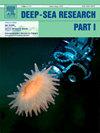Time series prediction of sound speed profiles in complex shallow water environment
IF 2.1
3区 地球科学
Q2 OCEANOGRAPHY
Deep-Sea Research Part I-Oceanographic Research Papers
Pub Date : 2025-08-16
DOI:10.1016/j.dsr.2025.104575
引用次数: 0
Abstract
Sound speed exhibits significant spatio-temporal variations in shallow waters, particularly in environments with internal solitary waves (ISWs). The temporal prediction of sound speed profiles (SSPs) can be transformed into the prediction of empirical orthogonal function (EOF) coefficients. However, dynamic oceanic phenomena can cause significant variations in the background field and EOFs, leading to representational errors. Studies have shown that the sound speed at the depth corresponding to the extreme point of the first EOF contains the most information, which can effectively reflect the SSP structure. To reduce the impact of the background field and EOF mismatch on SSP prediction accuracy, an indirect approach is proposed. Compared to directly predicting the EOF coefficients using a Long Short-Term Memory (LSTM) network, the indirect approach utilizes historical data to establish the relationship between the depth-fixed sound speed at a specified depth and the EOF coefficients using a back propagation (BP) network. The LSTM then predicts the depth-fixed sound speed for the test set. Finally, the EOF coefficients are obtained from the trained BP network and subsequently used to reconstruct the SSPs. A negative coupling relationship is observed between the first EOF component estimated by the indirect approach and the background field. This relationship causes the mutual cancellation of two error components, ultimately reducing the SSP prediction error. The indirect approach substantially enhances SSP prediction accuracy compared to the direct approach, reducing errors by approximately 0.9 m/s, reaching approximately 0.67 m/s. Moreover, it maintains high prediction accuracy with an error of approximately 0.57 m/s with a representative background field.
复杂浅水环境声速剖面的时间序列预测
声速在浅水中表现出显著的时空变化,特别是在有内孤立波的环境中。声速分布的时间预测可以转化为经验正交函数(EOF)系数预测。然而,海洋动态现象会引起背景场和EOFs的显著变化,从而导致表征误差。研究表明,第一EOF极值点所对应深度的声速信息最多,能有效反映SSP结构。为了降低背景场和EOF失配对SSP预测精度的影响,提出了一种间接方法。与使用长短期记忆(LSTM)网络直接预测EOF系数相比,间接方法利用历史数据在特定深度建立定深声速与使用反向传播(BP)网络的EOF系数之间的关系。然后LSTM预测测试集的深度固定声速。最后,从训练好的BP网络中获得EOF系数,并将其用于重建ssp。间接法估计的第一个EOF分量与背景场呈负耦合关系。这种关系使得两个误差分量相互抵消,最终减小了SSP预测误差。与直接方法相比,间接方法大大提高了SSP预测精度,将误差降低了约0.9 m/s,达到约0.67 m/s。在具有代表性的背景场下,该方法保持了较高的预测精度,误差约为0.57 m/s。
本文章由计算机程序翻译,如有差异,请以英文原文为准。
求助全文
约1分钟内获得全文
求助全文
来源期刊
CiteScore
4.60
自引率
4.20%
发文量
144
审稿时长
18.3 weeks
期刊介绍:
Deep-Sea Research Part I: Oceanographic Research Papers is devoted to the publication of the results of original scientific research, including theoretical work of evident oceanographic applicability; and the solution of instrumental or methodological problems with evidence of successful use. The journal is distinguished by its interdisciplinary nature and its breadth, covering the geological, physical, chemical and biological aspects of the ocean and its boundaries with the sea floor and the atmosphere. In addition to regular "Research Papers" and "Instruments and Methods" papers, briefer communications may be published as "Notes". Supplemental matter, such as extensive data tables or graphs and multimedia content, may be published as electronic appendices.

 求助内容:
求助内容: 应助结果提醒方式:
应助结果提醒方式:


